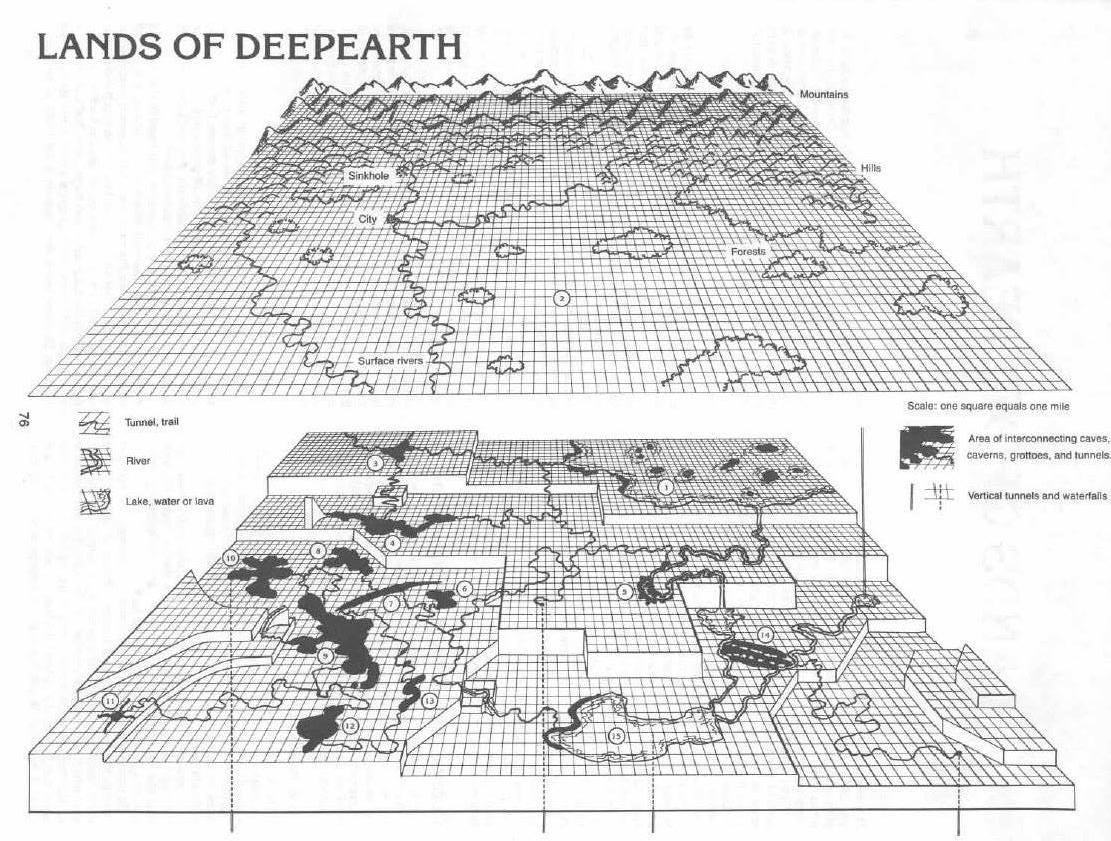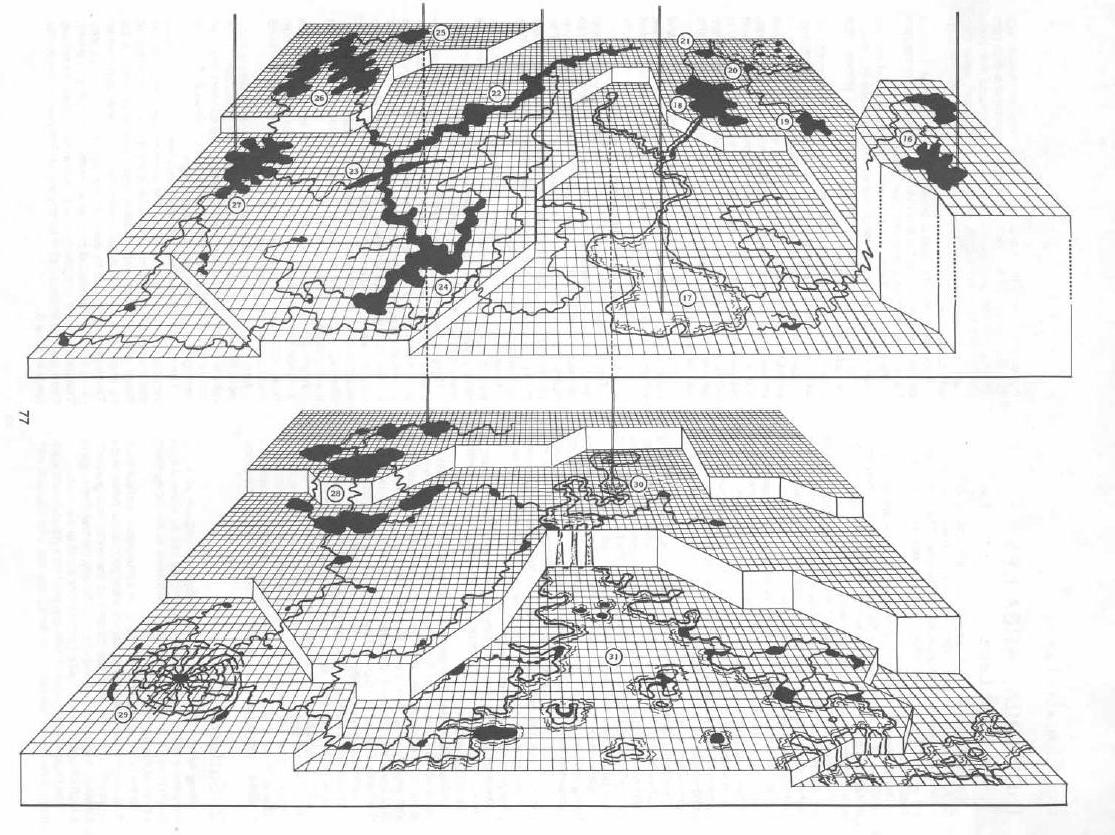



|
|
|
|
|
|
|
|
|
|
|
|
|
|
|
|
|
|
|
|
|
|
|
|
|
|
|
|
|
|
|
|
|
|
|
|
|
|
|
|
|
|
|
|
|
|
|
|
|
|
|
|
|
|
The Lands of Deepearth are presented in
detail as a setting that
you can use for your underground campaign.
The known varieties
of intelligent life each claim a portion
as their own, and a
group of PCs can gain many levels and
overcome
towering obstacles, without exploring
Deepearth in its entirety.
If you prefer, regard the lands as an
example of the underground
ecosystem and its many components. Utilize
those
aspects you like in your own campaign,
and disregard others.
Expand this area as much as you wish-as
presented, the realms
of Deepearth occupy no more area than
a moderately small
nation. Certainly there is potential for
many such underground
realms under the lands and seas of the
fantasy world.
The realms of Deepearth are mapped on the
following pages
for your easy reference. Each numbered
area on the map is presented
in rough detail, including a description
of the overall geography
of the region, its major inhabitants and
resources, and any
unique features you might find useful
in adventuring. Obviously,
each area must be mapped in more detail
if you plan to run your
campaign there. If you wish to add some
three-dimensional detail
to your mapping, see page
114 for suggestions. Geomorphic
mapping is also described there and can
be a great time-saver if
your PCs spend a lot of time adventuring
in the regions of
Deepearth.
If you are employing one of the Hollow
Earth theories, note that
the region of the hollow earth lies below
the areas depicted on the
map of Deepearth. You will probably wish
to create shafts or tunnels
leading down from the lowest level of
Deepearth.
Connecting Passages of Deepearth
The map shows a number of connecting links
between the
major inhabited regions of Deepearth.
Some of these are shown
as waterways, while
others are presented as tunnels. All connecting
passages are large enough to be passable
to human-sized
characters. Other factors, such as vertical
obstacles or water currents
are handled on an individual basis in
the area description,
or can be generated randomly by the DM.
The waterways
shown on the map are rivers flowing through
the vast dark reaches
of Deepearth. With a quick look at the map,
it should be easy
to determine which direction each river is flowing.
With the exception
of waterfalls, the rivers proceed at a rapid
pace or slower,
sometimes becoming almost stagnant in their
sluggishness.
All vertical drops,
or waterfalls, are indicated on the map. Use
the map scale to
determine how far a waterfall drops. All other
sections of underground
waterways are navigable by boat,
assuming a skilled
pilot and a little luck.
To determine the
width of a section of waterway, roll ld6 and
multiply the result
by 10, for a possible spread of 10-60 feet. The
width remains constant,
with minor fluctuations, for one mile,
after which you
must roll another d6. On a 2-5, the river remains
at approximately
the same width. If the result is 1, the river
decreases in width
by 10 feet (or 5 feet, if it is already only 10 feet
wide). If the result
is a 6, the river expands its width by 10 feet,
even if this makes
it wider than 60 feet.
The water in underground
rivers is usually numbingly cold. To
check the temperature
of a given area, roll 1 d6. On a 1-5, the river
is very cold. On
a 6, some heat is reaching the water. To determine
how warm the water
is, roll another d6. On a 1, the water is
cool, but slightly
warmer than normal. On a 6, it is boiling hot. A
result ranging from
2-5 means a degree of warmth proportional to
the roll. Only water
that is boiling hot is unsafe for unprotected
characters to swim
or fall into.
The tunnels connecting the larger realms
of Deepearth are all
of sufficient diameter to allow a human
to pass, and often are
much wider than this. In most cases, these
tunnels are natural
caverns, but about 1 out of every 10 miles
(10% chance) has
been carved by intelligent creatures.
In cases where excavation
has occurred, the tunnel is a uniform
10-foot diameter and height,
with no sudden obstacles such as cliffs
or chasms.
There is a base 33% chance per mile that
an obstacle lies in
the path of the PCs as they explore natural
caverns. The obstacle
might be a cliff of 10d10 feet height,
or a chasm 20d10 feet deep
and 4d10 feet wide. Other possible obstacles
include the remnants
of a cave-in, or a large pool of water,
quicksand, oil, or tar.
The obstacle never completely closes off
the passage, however.
The caverns range from 3-60 feet (3d20)
wide. Once a width
has been established, it remains constant
for 100-2,000
(1d20 x 100) feet. After this distance,
it stands a 113 chance of
changing. If a change is indicated, reroll
the 3d20 to determine
the new width of the passage.
Various unintelligent monsters, including
scavengers, occasionally
live in these passages, as do a wide variety
of fungi,
molds, and lichens. However, intelligent
creatures do not dwell
here. If an encounter with drow or any
of the other intelligent
Underdark denizens is desired, it can
certainly be designed, but
the encountered individuals will be passing
through the tunnel,
not living there. Of course, renegade
bands that have been banished
from their homelands might try to eke
out an existence in
the tunnels.

The map provided shows much too large an
area to be fully
detailed in this volume. Instead, an overall
framework is given
and the DM is free to fill in the necessary
details. Each numbered
area is described in terms of its overall
geography and origin, as
well as its most significant inhabitants.
Any available resources
and any unique features are also described.
In terms of specific areas, however, you
need to create some
maps of your own. General information
indicates the overall
parameters of an area. For example, if
a dungeon is described as
occupying a 300-foot-square area, this
means that the dungeon
can be mapped in a 30 square by 30 square
section of graph
paper, not that the dungeon is one huge
room, 300 feet long on a
side. If you donít have time to prepare
a map, consider using the
Random Dungeon
Generation system in the DMG, page 169.